How To Create Mobile Apps For Android
From small business apps to ecommerce apps, fitness apps, internal employee communication apps, religious apps, and more—there's an app for anything you can imagine.
Apps can be developed as an extension of your existing business or used to create new business from scratch.
Whether you want to develop an app for your business or build the next Uber, this guide is for anyone who wants to create a mobile app.
For first time builders, non-technical users, and anyone who has experienced a failed development attempt in the past, this resource will walk you through the app development process in a way that's easy for everyone to understand.
How to Make an App: A Step-by-Step Guide
Mobile app development can be segmented into three categories—pre-development, development, and post-launch.
This guide reads best from start to finish, but feel free to click around to the sections that are most relevant to your needs. Some of you might be starting from scratch, while others might be further along in the process.
Table of Contents:
- How to Create an App — Introduction
- What's the Best Way to Build an App?
- How Long Does it Take to Build a Mobile App?
- How Much Does it Cost to Make an App?
- Is it Better to Build iOS Apps or Android Apps?
- How to Create an App in 10 Steps — (Step-by-Step Tutorial to Make an App)
- Step #1 — Define Your Goals
- Step #2 — Conduct Market Research
- Step #3 — Create a Wireframe
- Step #4 — Choose Your Development Method
- Step #5 — Research Existing Solutions
- Step #6 — Technical Specification
- Step #7 — Set Measurable Milestones
- Step #8 — Create an MVP
- Step #9 — Quality Assurance
- Step #10 — Deploy
- Post Launch
- Marketing Your App
- Track KPIs
- Gather Feedback
- Make Improvements
- Maintenance and Support
- How Do You Make Money With an App?
- How to Make an App – Create App FAQ
- How to Build an App: Conclusion and Key Takeaways
How to Create an App: Introduction
Before we dive into the step-by-step process for building an app, let's quickly cover some of the most common questions about mobile app development. These answers will give you the preliminary insights required to get started.
What's the Best Way to Build an App?
Generally speaking, there is no single app development method that's best for everyone. It all depends on your needs, budget, app type, industry, and lots of other factors.
If you're building a gaming app or something along those lines, native development will be your best option. If you're making an app as a hobby or just doing it for personal use, you can probably get away with a cookie-cutter app.
But for the vast majority of people, using an app building platform like BuildFire is the best way to create an app.
BuildFire allows you to create an app for iOS and Android, simultaneously, without writing a single line of code. For non-technical users and tech-savvy individuals alike, BuildFire is the best way to build an app that's highly customizable at an affordable rate.
How Long Does it Take to Build a Mobile App?
The time it takes to build an app is based on a wide range of factors. The type of app you're making, the complexity of its features, and the development method are three of the most critical elements in estimating your timeline.
Some apps can be built in a few months, while others can take years.
Generally speaking, the majority of mobile apps can be developed in about 6-12 months.
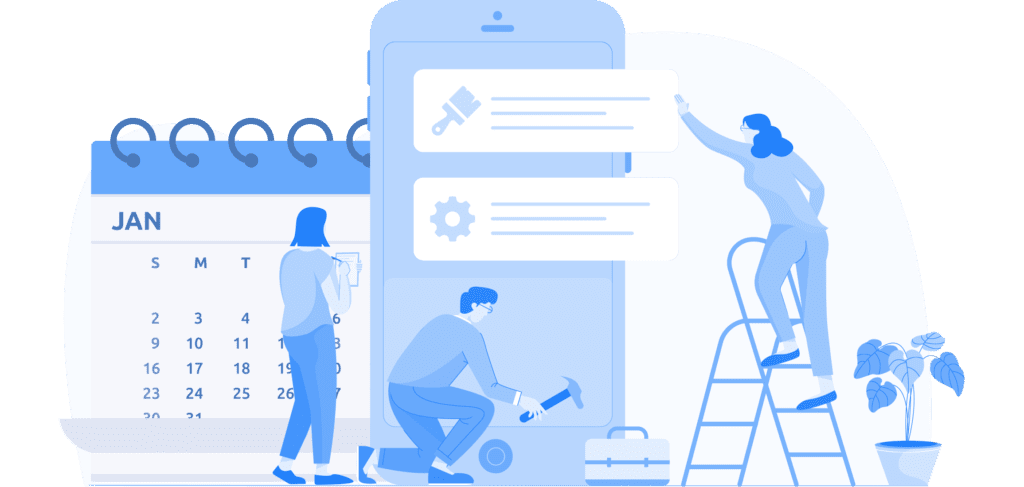
Mobile apps with complex functionality will take longer. If you were building something simple for personal use, like a flashlight app or calculator app, the entire process could be completed in less than a week. But if you're trying to build the next Facebook, Uber, or Tinder, expect it to take years.
If you're building a native app with low-level coding, it would take longer than if you leveraged an app building platform, like BuildFire.
How Much Does it Cost to Make an App?
The cost to create a mobile app is based on multiple factors. The type of app you're building, the features you're implementing, and the development method will have the most significant impact on the price.
You can build an app for $2,000, $20,000, $200,000, or upwards of $2 million.
In most cases, using an app development platform will be cheaper than learning how to develop an app from scratch by coding. But even within each development method, the prices will fluctuate.
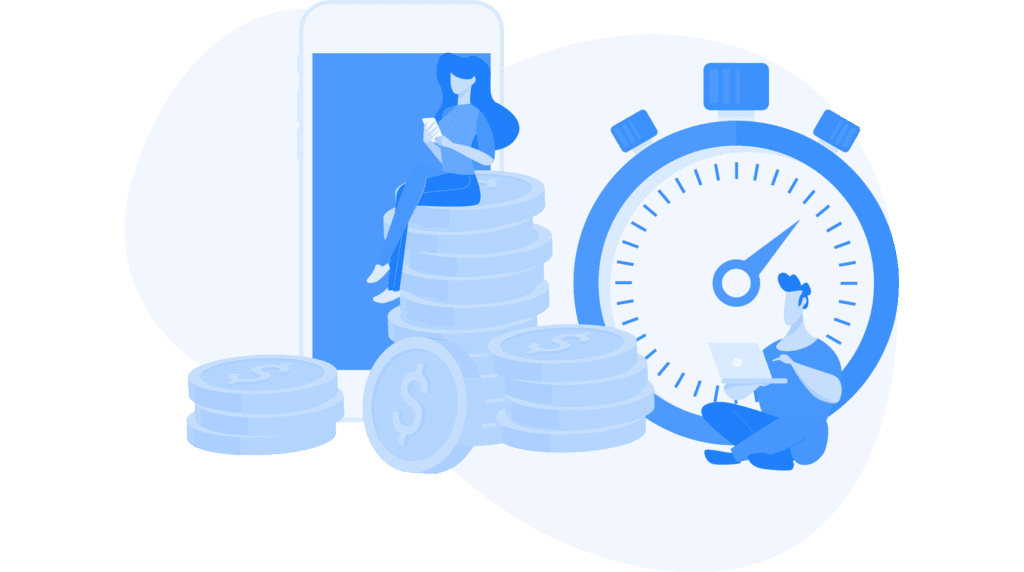
For example, let's say you want to build an app with low-level coding. You can hire an experienced app developer in the US that charges $150 per hour or outsource to a first-time developer overseas for $30 per hour.
If you try to cut corners and develop your own app for as cheap as possible, your final quality will suffer. It could end up costing you more money in the long run if you try to save a few dollars now.
Is it Better to Build iOS Apps or Android Apps?
The quick answer—it's best to build an app for both platforms. If you create an app for one and not the other, you're neglecting a significant part of the population.
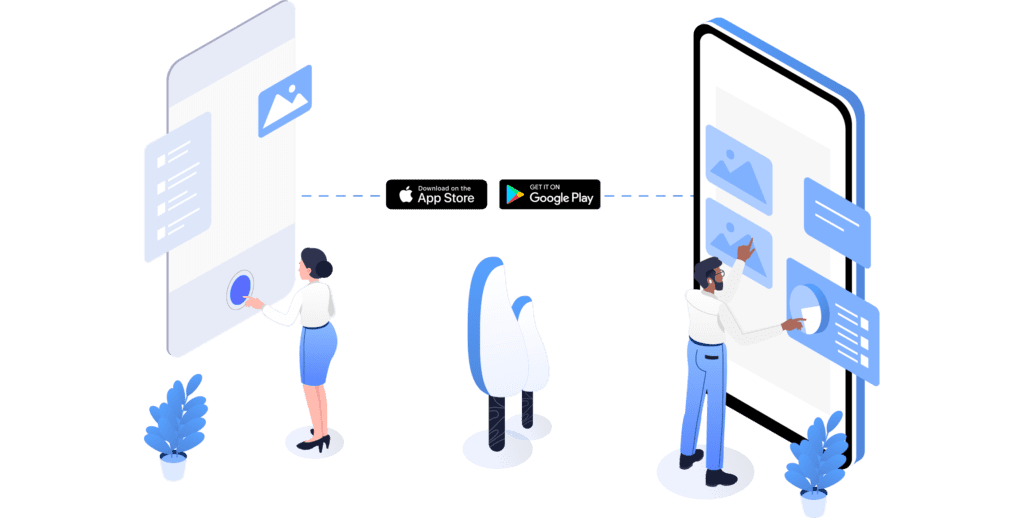
You're only forced to make this decision if you're coding a native app from scratch. In this case, you'll need to have two separate versions—one for iOS and another for Android. It's essentially like building two separate apps.
Fortunately, app building platforms, like BuildFire, allow you to create an app for iOS and Android simultaneously. You can create everything one time, without any code, and launch your own app on both platforms.
How to Create an App in 10 Steps – (Step-by-Step Tutorial to Make an App)
While it's tempting to start building right away, there are certain steps you need to take before development begins. These steps are critical to the success of your app, so don't skip over them.
Step #1 — Define Your Goals
The app development process must start with clearly defined goals.
What are you setting out to achieve? What problems are you trying to solve?
Your goals will ultimately establish your entire development process. If these aren't clearly defined from the beginning, it's easy to get lost along the way once you start developing your own app.
Don't just set any goal—set measurable goals.
Use this as your north star, to ensure that you're continually aiming toward them. Otherwise, you won't be using your time and resources effectively. Since app development is virtually limitless, it might be enticing to add features, bells, and whistles that aren't mission-critical to your goal.
You can set goals related to the end-user, as well as goals related to your business.
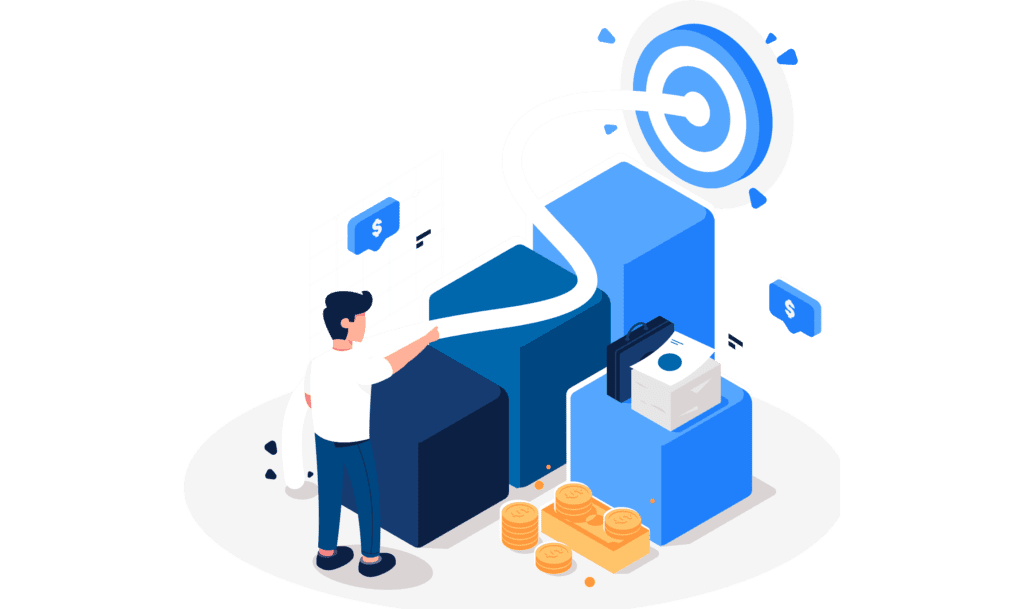
To make sure that you achieve your app development goals, you need to understand the difference between a goal and an objective. Goals represent the final outcome that you want to reach. Objectives are the steps you take to achieve those goals.
Break those objectives down into "SMART" objectives:
- Specific
- Measurable
- Achievable
- Realistic
- Timely
It's a common mistake for people to define goals in a monetary sense, such as "make more money." But that goes without saying. It doesn't make you different from every other business on the planet. Instead, a great goal should be focused on your purpose and mission.
Every goal should have clear KPIs (key performance indicators).
Make sure that you have pre-defined measurements to achieve success. KPIs work best when they are numerical.
For example, let's say you want to create an app for your ecommerce shop, one of your goals might be to reduce shopping cart abandonment rates on mobile devices. To make sure that you're reaching that goal, you need to know your current abandonment rates to compare them against the numbers when your own app eventually launches.
Step #2 — Conduct Market Research
Once you've established your goals, you need to make sure that there's a market need for your app. Every app idea sounds good in theory, but you need to validate your idea before you proceed.
It's much better to conduct your market research now before development begins. Otherwise, you could waste valuable time, resources, and money on app ideas that the market doesn't need.
If the app is for your existing business, talk to your customers to understand what they want. It's easy to assume that your customers want certain features, but the only way to know for sure is by taking the time to learn more about them.
Create surveys. Conduct interviews. Run a focus group.

Figure out how to create an app that will improve the experience of your current or prospective customers?
Research your competition. Are there other businesses or apps out there doing the same thing? How can your app do it better?
Your can't have the exact same app as another business. Your app must have a differentiation factor that separates yourself from the competition. Think of the problem your app solves and how potential app users will benefit from it. This will be your competitive advantage.
Without establishing your differentiation, users won't have a reason to choose you over other players in the industry. Remember, you're likely going to be competing against businesses and apps that have beat you to the market. How are you going to catch up to them?
For those of you who are lucky enough to have first-movers advantage, how will your app be different from the ones being built after you?
All of this information must be clearly identified in your market research.
Step #3 — Create a Wireframe
If you've never built a mobile application before, you might be wondering what a wireframe is. Fortunately, it's very easy to do this before you create an app.
A wireframe is essentially a rough layout of your mobile app. It doesn't have to be too formal either, and you don't need to worry about your app's graphic design just yet. You can create a wireframe on a piece of paper, a whiteboard, napkin, or use a digital wireframing tool.
The purpose of the wireframe is to simply illustrate the app's features and layout the schemes.
Don't worry about the app design elements in a wireframe. This tool isn't meant to be a one-to-one relationship of how the final app will actually look. Instead, the focus of your wireframe should be on structure and flow.
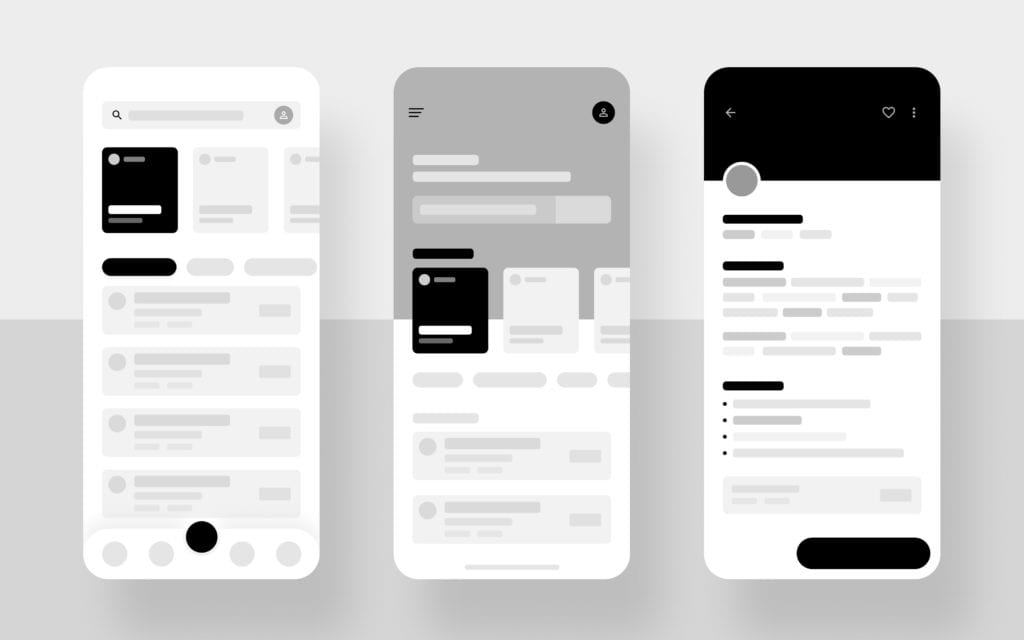
Map out the user journey. Show what happens if they click on a particular button. What will the next page look like? What happens on the screen when a user clicks Option A vs. Option B?
Here's an analogy to express the importance of wireframing. Let's say you wanted to build a house. You wouldn't start breaking ground on day one, would you? Instead, you'd sketch the plans on paper. Then you can take those plans to an engineer or an architect and explain what you want. They'll take those plans and use them to create the schematics for the blueprints. It's much easier to make those changes on paper before you start pouring concrete or putting up walls.
The same concept can be applied to mobile apps. It's much easier to make changes on paper before you actually start building anything.
A wireframe can also help get your team on the same page in terms of your vision for how the app will work and function.
Step #4 — Choose Your Development Method
There are lots of different ways to build an app. Before you start to create an app, you'll need to determine which method is the best for your unique situation.
The best option for me might not be the best option for you.
Choosing the right method is based on factors like your budget, technical skill level, app type, and time to market.
Generally speaking, there are five different ways to build a mobile app. I'll explain each method in greater detail below, so you can figure out which choice is the best for your own app.
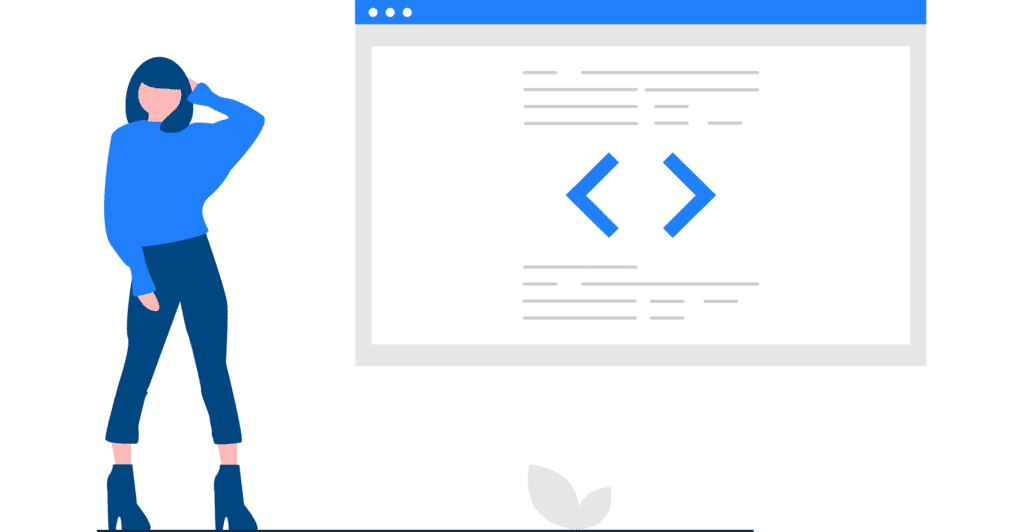
How to Create an App With Native Development
Native development involves low-level coding. So if you're not a developer and you don't know how to code, you'll need to hire a specialized developer to create the app for you.
If you're planning to launch the app for both iOS and Android, you'll need a developer for each platform to deploy native apps on both app stores (iOS App Store and Google Play Store).
Each platform has its own programming language. While some developers know how to create an app for both, it's going to take you twice as long to have one person doing the whole thing, and it won't save you any money. Alternatively, you can have two people working on the app simultaneously to get to market faster.
For example, app developers can use Android Studio to create native apps using Java, C++, and other common programming languages. While that app will be fine for Android apps on the Google Play Store, you need a separate build for iOS apps on the Apple App Store.
In addition to hiring app developers to make an app, you'll also need a full stack web developer to create your backend infrastructure for data hosted in the cloud.
Your app development team won't be complete without a QA specialist to handle testing and a project manager to oversee everyone's duties.
Learning how to build an app with native development gives you the most flexibility of any development method. By coding from scratch, your app can do anything. It's an ideal option for anyone trying to build a gaming app or an augmented reality app.
With that said, native apps are expensive and take the longest to build.

How to Create an App With Hybrid App Development
Hybrid development is a cost-effective alternative to the native route. Most hybrid builds rely on Javascript, which is a web technology.
This coding language allows you to create an app once and deploy it on multiple platforms. Someone who knows how to write in Javascript can code the app one time and deploy it on iOS and Android.
The flexibility of a hybrid app is still pretty high in terms of what the app can accomplish. While you won't need a developer who specializes in low-level coding to build it, they still need to have web development skills.
Overall, hybrid development will save you time and money compared to native development. However, you can expect a hybrid app's performance to be slightly below the performance of a native app. Fortunately, for most people, the slight performance hit won't make a difference in the app's success.
With today's Internet speeds, the difference in performance is shrinking dramatically. You can create an app that's UI-intensive using hybrid development without any noticeable problems.
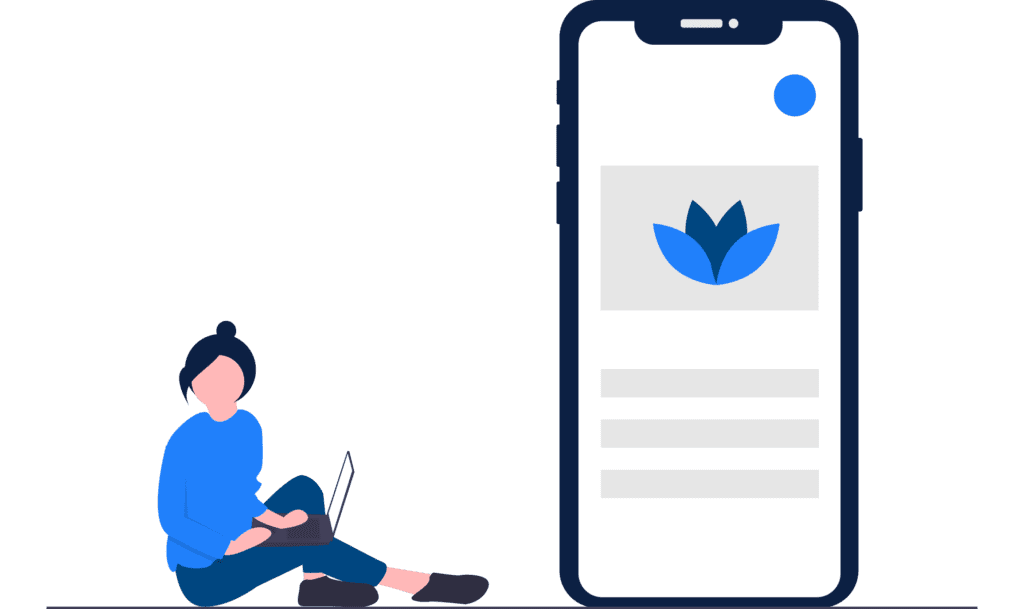
How to Create an App With a Rapid App Development (RAD) App Builder
Rapid app development is a popular choice for non-technical users who want to build an app on their own. It's much cheaper than native and hybrid development, and you'll be able to get to market faster as well.
With RAD, you'll use an existing tool to create an app with an online interface.
These platforms are typically promoted as solutions for people who aren't technical. But with that said, you'll need to have some clue of what you're doing from a technical perspective if you want to create an app using this method, even if you have a simple app idea.
You won't have to learn how to develop an app with code or do anything like that, but you will definitely need some technical ability to make your app do anything beyond a basic level.
Rapid app development limits the builder to whatever tool they're using to create the app. You'll only be able to use whatever that platform has to offer for functionality. You're just simply configuring those tools in a way that works for your app.
Let's say you want to create an app for something basic like a mobile application for internal processes, RAD will be a viable option. Just understand you'll have limitations.
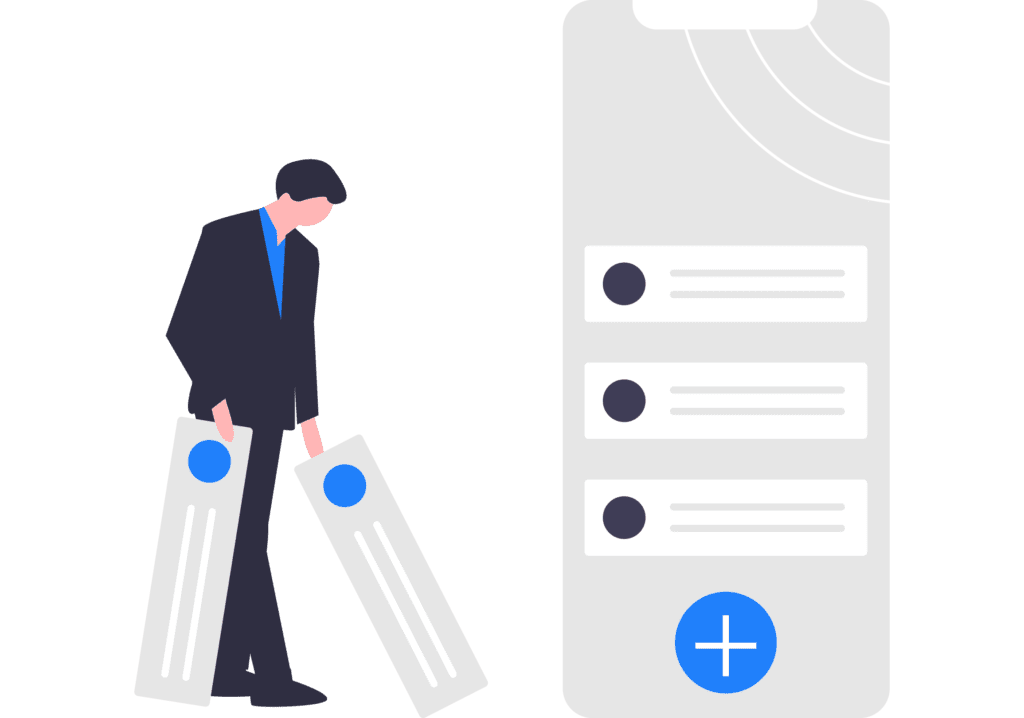
How to Create an App Using a Cookie Cutter App Builder
A cookie-cutter app app maker is exactly what it sounds like. You're essentially taking a single app and configuring it for your own needs.
You'll add personalized text, images, color schemes, and other app design graphics that align with your branding.The platform makes it easy for you to turn on functionality that you need, and turn off features that you don't.
There is no coding required for this development method. A cookie cutter app builder typically has a fairly simple user interface. So you don't need to be technical to figure this out.
While the difficulty level of creating an app this way is pretty low, the flexibility is low too. You can't really create anything too exciting or customized with a cookie-cutter app. The functionality will be extremely limited. If you want your app to scale, the platform you're building it on will restrict you.
With that said, cookie cutters are fine for those of you who want to create an app as a hobby. It's a good solution for people with low budgets who want to get to market as quickly as possible. Just understand that the potential for your app has a very low ceiling. You can still use these to build a complete app. But it's not really viable for business purposes.
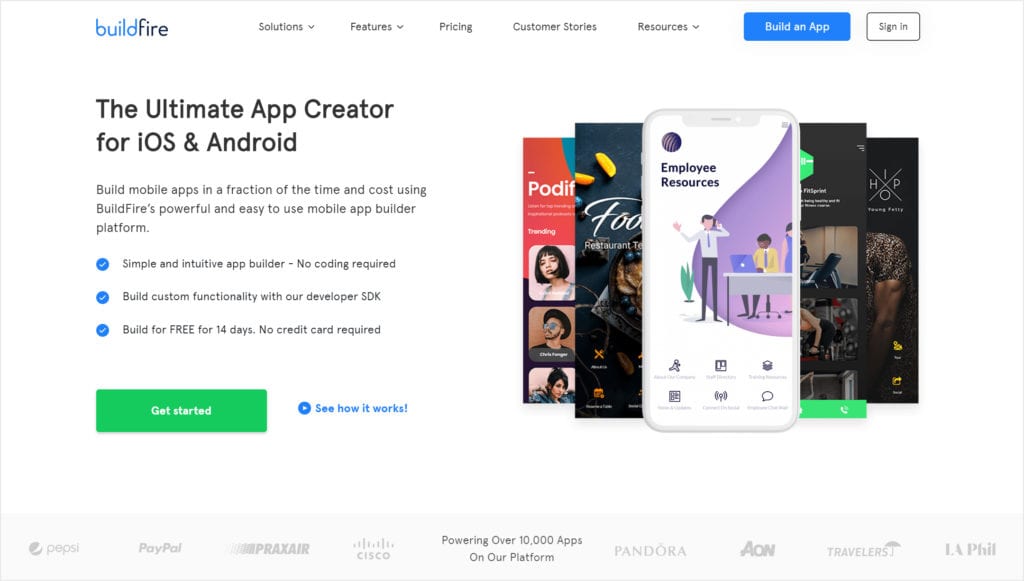
How to Create an App With BuildFire
BuildFire is in a category of its own.
This app building software was created to give non-technical users the ability to create apps on their own using an extensive marketplace with a plethora of features for complete customization.
Compared to the average RAD app builder, BuildFire offers greater flexibility in terms of what these native app can accomplish. If there's a unique functionality that hasn't been built for the marketplace yet, you can get your own developers to make it for you using the BuildFire SDK.
You'll also have the option to take advantage of BuildFire's white-glove services. In this case, the in-house developers at BuildFire can create custom functionalities for you.
To create apps with BuildFire, you won't need any coding skills. No need to use Android studio for Android apps, and you won't have to learn a new programming language to build apps for the Apple App Store.You can create everything on your own using a web-based platform, and launch an iPhone app and Android app simultaneously.
As an app owner, BuildFire has everything you need to make an app and create an app business through a seamless user interface. You can take an app idea and starting building apps immediately without any special training or instructions. Just start with a professional app design template and start adding features.
It's the easiest way to develop iOS apps and deploy on the iOS App Store and Google Play Store. Anyone can learn how to make an app using BuildFire in just a few minutes.
BuildFire is a cost-effective way to build an app that's customizable without the challenges associated with other RAD or hybrid tools.
Step #5 — Research Existing Solutions
The final step you need to take in the pre-development process is researching existing solutions. Before you waste valuable time and resources figuring out how to build an app and other components from scratch, it's always a great idea check to see if that solution is already available on the market.
Let's refer back to the house-building analogy that I used earlier. You could get a carpenter to build every aspect of your kitchen from scratch, from custom drawers to windows and cabinetry. But why would you need this? You can simply buy cabinets that have already been built and just install them in your kitchen.
In terms of app development, there are services to accomplish standard functionalities that every app needs. I'm referring to solutions for things like infrastructure, hosting, design, analytics, and push notifications.
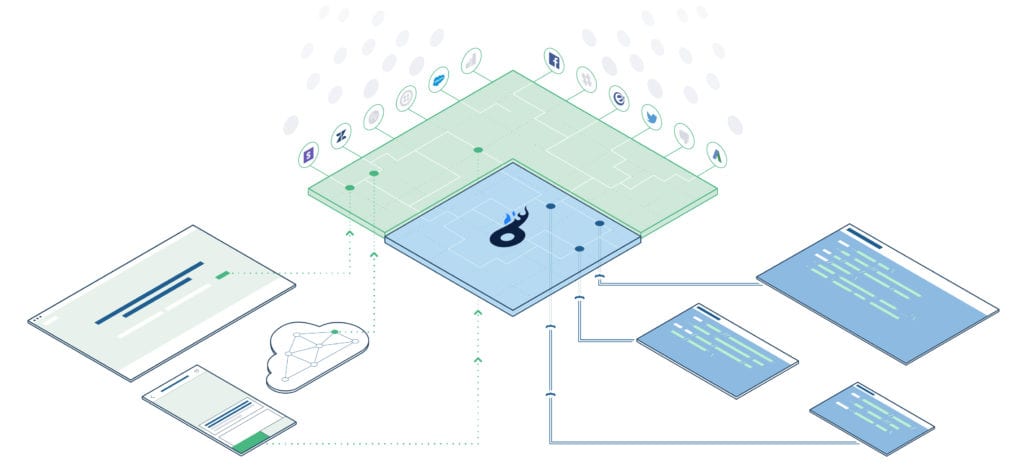
Why would you try to host an app on your own if you can just rent servers from an existing solution?
It's always cheaper to buy something pre-built as opposed to building it on your own from scratch. You can usually make slight custom changes to these existing services as well.
Learning how to make an app is challenging enough. Don't make this process more difficult than it needs to be. Only build what you need from scratch. For everything else, just leverage reusable tools that already exist.
This will save you time, money, and get your app to market faster. Plus, it will make your life much easier.
Once you complete the legwork in the pre-development stage, you can actually start to create an app. By now, you've already validated your app ideas, done all of the necessary research, and have a basic understanding of how the app should function.
Step #6 — Technical Specification
Take the wireframes that you created during the pre-development process and use them to create a "tech spec."
Think of this in terms of the building a house analogy that I keep referring back to. The tech spec can be compared to the civil engineering process. There are lots of factors to take into consideration before construction starts. You've got electrical, plumbing, ventilation, and things of that nature.
These are the inner workings behind the walls of your house that nobody sees. Sometimes, it makes sense to logistically change things around because it will save you lots of time and money.
For example, in a two-story house, you might put a bathroom on the second floor above the kitchen because the plumbing can easily be connected. In the initial design (wireframe), the bathroom might have been somewhere else. But the civil engineer says that it will save time and money if you align them together.
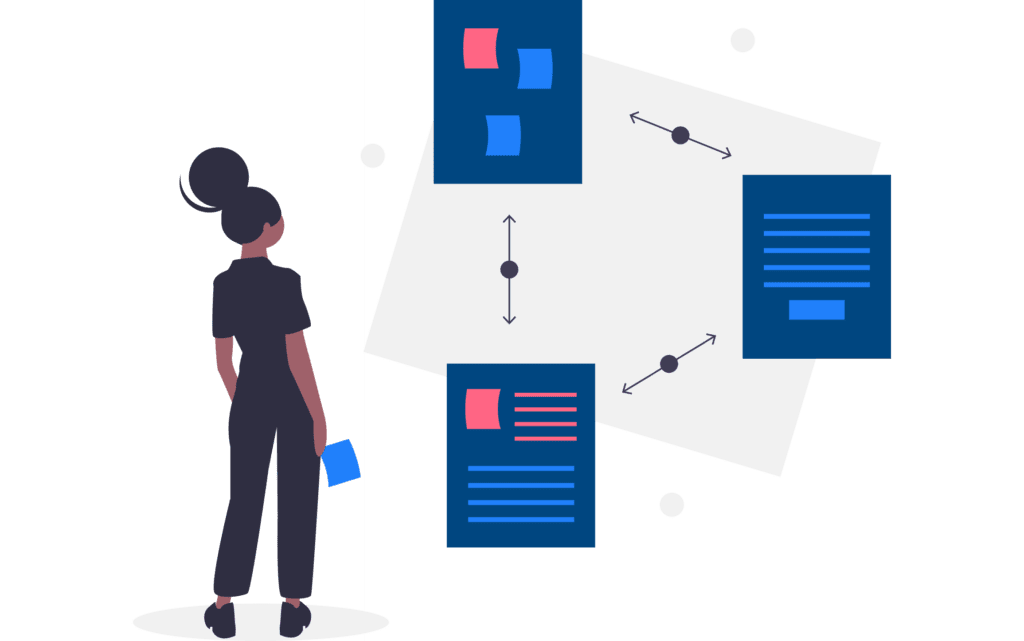
This same concept can be applied to mobile apps. The technical specification process gives you an added insight into the inner workings of your app.
An app developer needs to look at your wireframe and assess the technical challenges—not just the visual ones.
Your tech spec can potentially find alternative ways to achieve your goals. These alternatives can save you months of work and thousands of dollars if you figure it out now.
At the very least, get the information, and then you have the opportunity to weigh your options.
You can always say that the user experience is more important than shaving off some of the costs and building more efficiently. But the tech spec process is still a crucial part of development.
It's better to do it right away, as opposed to three or six months down the road, thinking, "I wish we did things differently. It could have saved us so much time."
Step #7 — Set Measurable Milestones
Setting milestones will help keep you and your team on track during the app making process. Without benchmarks, you'll have no way to track your progress.
The idea here is to separate your massive development project into smaller chunks. It's much easier to chip away at lots of smaller projects than to look at one huge project from start to finish.
Each small app project should be completed within a specified timeframe. Depending on the complexity of the task, this could range anywhere from a few days to a few weeks.
You can measure your progress against this timeline of milestones to ensure that you and your development team are hitting deadlines.
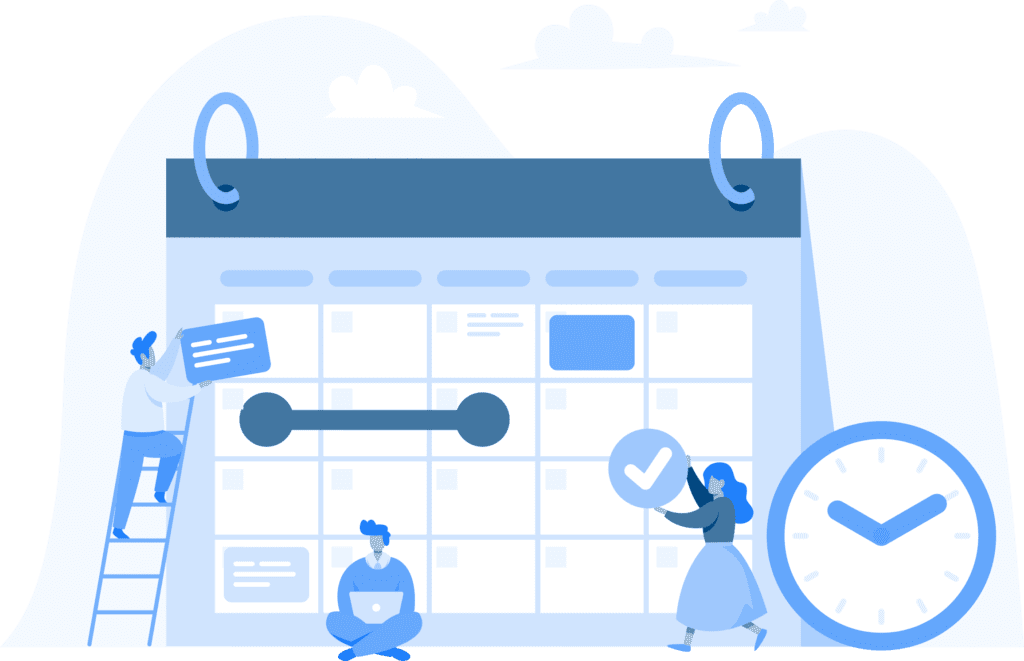
The best way to optimize this process is by learning a project development system. Agile development and scrum development are both prevalent project management methodologies amongst software developers.
If you decided to manage the app project on your own, it's definitely in your best interest to learn one of these methodologies. For those of you who decide to hire a project manager, they'll likely implement their preferred management methodology.
Regardless of your decision here, you need to make sure that you have a way to track your progress.
This will give you a better understanding of when you can go to market with your app—so you can plan accordingly.
Step #8 — Create an MVP
As you start building the app, you should always be developing an MVP—minimum viable product. The app idea behind an MVP is that it forces you to think about your app's most essential features. This an important aspect of the app project on the path to creating a successful app.
What does your app actually need to function? Build those features first, then worry about everything else.
App development is virtually limitless. It's easy to get distracted during the building process and lose sight of your goals. A month or two into the project, it's easy to say "let's add this feature" or "wouldn't it be cool if the app could do this?"
Those notions will only add time and money to your project. They can even take away from the core functionality of your app.
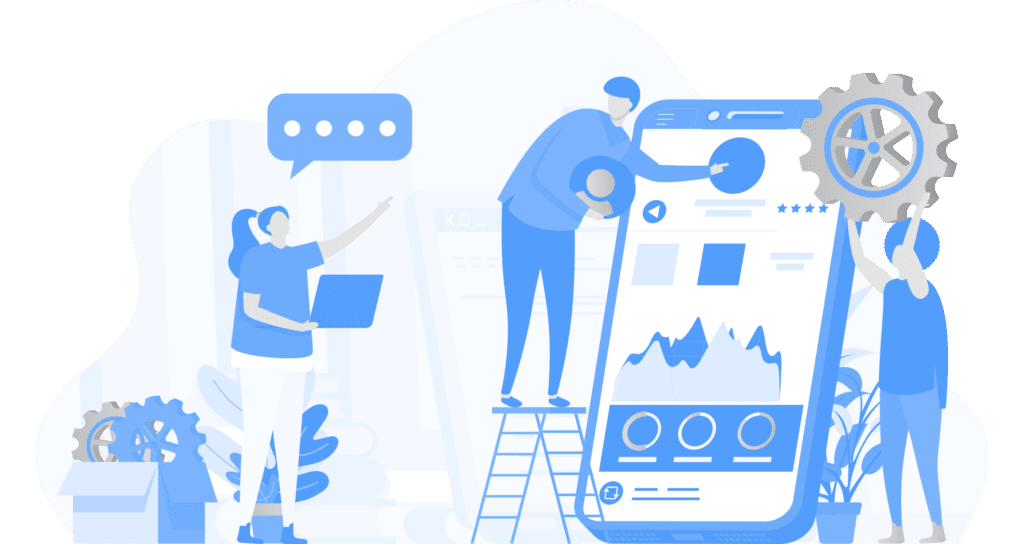
You could always go back and add features later. In fact, we'll address this shortly in the guide during the later stages of the app making process.
An MVP is essentially the bare bones of your app. Figure out how to make an app with just its necessary components. It has just enough of the core features to complete the simplest functionalities and use cases. Don't worry about a beautiful design or distracting bells and whistles. That's not important right now.
For example, let's say you're building a messaging app.
Your MVP would be an app that allows two users to send messages to each other. You wouldn't start building a video chat feature or configure settings to change the font, upload photos, or adjust the background color of the app.
Let's refer back to the house analogy. The MVP for a house would be four exterior walls and a roof. It wouldn't be a tent, and it wouldn't be a kitchen. You can't go from a tent to a house, and a kitchen can be added later.
Remember, an MVP is not a complete app but it's more than just a test app.
Step #9 — Quality Assurance
Once your MVP is finished, and you have a working app, you need to test it before deployment.
The app must be tested on actual mobile platforms. There are many different ways your app can be used, so the quality assurance person will have to check it on everything.
Between iPhones, iPads, Android devices, PWA, smartphones, tablets, and more, you have your work cut out. Make sure the app works online, offline, and so on. Devices with different software versions or screen sizes might have issues that aren't found elsewhere.
So don't just test the app once on your phone and assume that it's working correctly.
As a first-time app builder, you might question the QA process. Do you really need to pay someone to test your app? Shouldn't an app developer be able to create an app without any bugs in the code?
Sure, in utopia, apps get built perfectly and don't need to be tested. But in the real world, developers write bugs—and they are notoriously bad at finding their own bugs.
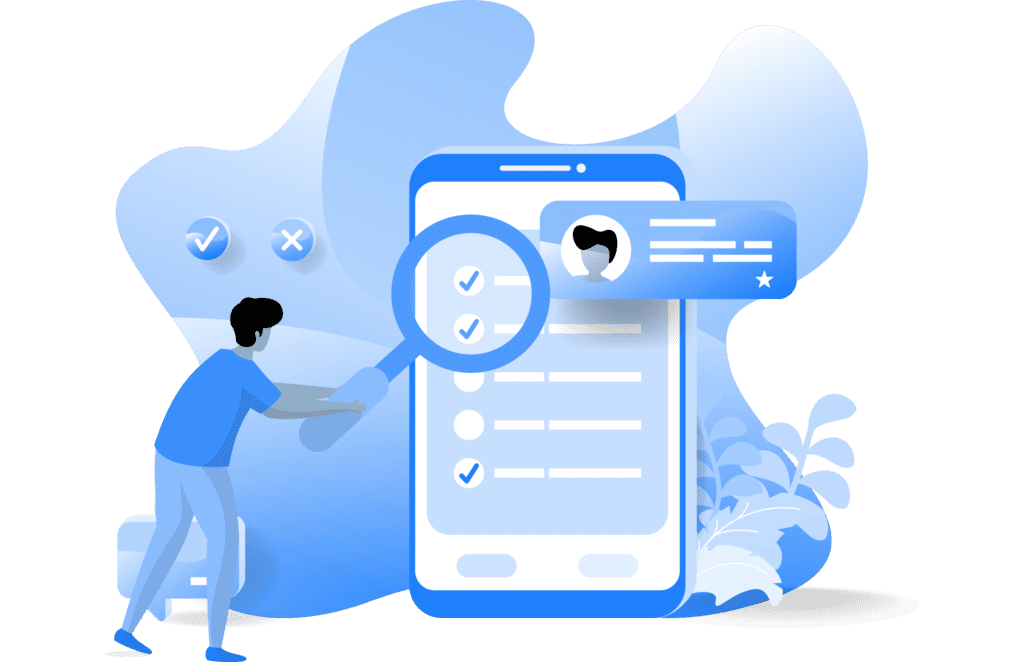
So don't undermine the QA process. A quality assurance specialist can come in and find problems with your app before it goes to market. It's much better to identify these now; otherwise, users will find them in real life.
If a customer discovers bugs, it's going to create problems for your app's long-term success.
In addition to testing your app with a QA specialist, you can also go through usability testing with actual test users. Give the app to your friends, family, and colleagues as well.
The app doesn't need to be perfect when you launch it. But ideally, you'll want to eliminate all of the bugs and errors. User experience and user interface changes can be configured later.
Step #10 — Deploy
The final stage of the development process is deployment. It's time to get your app live and into the hands of actual users.
Don't worry about backward compatibility or anything like that. Right now, your primary focus needs to be uptime and visibility. Make sure that the application is fully functional for the end-user. The last thing you want is for your servers to crash or something like that.
There are many different software options and tools on the market that you can use to ensure that the app is healthy and that the software is responsive.
In order to get your app to market, you need to submit it to the different app stores. There are various requirements for Google Play Store apps and Apple App Store apps. So you must understand all of the different submission guidelines before you go through this process.

Otherwise, your app could get rejected from the store, which is obviously something you don't want to deal with. It just delays your launch and gives you more headaches that could have been avoided. Imagine going through the entire process learning how to create an app, only to get rejected?
The process of deploying your app will vary depending on the development method you choose, which we discussed earlier in the pre-development section of this guide.
If you use BuildFire to create an app, we'll get the app live for you. All you have to do is let us know when it's done, and we'll take care of everything else for both iOS and Android. So you can focus your efforts on development, and let our team do all of the heavy lifting for you.
For those of you who decide to hire a development team or learn how to make an app on your own writing code, you'll have to go through extra steps during the deployment process. There won't be any magic button to push where a team of experts can come to the rescue.
Post Launch
So you've learned how to build an app; that's great! But he mobile app development process isn't over once the app has been deployed. There's still plenty of work to be done after you've launched.
Make sure that you plan accordingly for the post-launch steps, and don't blow your entire budget during development.
Marketing Your App
Your app is a business; treat it accordingly. Would you launch a new business without any promotion? Obviously not.
You could have the best app on the planet, but your efforts won't matter if nobody knows about it. Your app must be marketed appropriately to get some eyeballs on it and pique user interest.
Start by driving visitors to your website and app. Visitors become app installs. App installs become paid members.
Make sure you have a digital presence on as many marketing platforms as possible. Prioritize the channels where your user base spends the most time. Promote your app on social media channels, like Facebook, Instagram, Twitter, and LinkedIn. If you're targeting a younger generation, you can even promote the app on Snapchat and TikTok.
Create video promotions and app demonstrations. Upload those videos to YouTube. You can always repurpose those videos on other distribution channels.
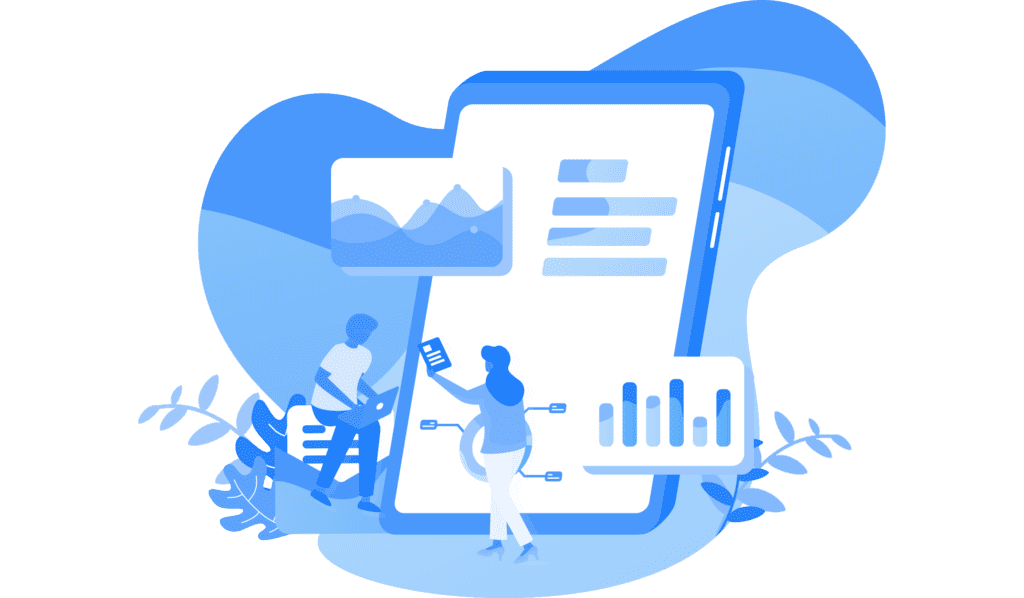
The idea behind your mobile app marketing strategy needs to be focused on attracting new users. So broaden your reach and use a mix of both inbound and outbound marketing strategies.
In the short term, you can run PPC (pay-per-click), and CPI (cost-per-install) paid ads to drive downloads. But long term, you should be blogging and focusing on SEO (search engine optimization) tactics for driving traffic to your website. This will ultimately help your app gain more attention when users search for solutions via search engines. Plus, focusing on free app promotional strategies will help you keep your costs low over time.
You should also understand the basics of ASO (app store optimization) and app meta data. By leveraging ASO techniques, it increases the chances that users will find your app organically while they're browsing in the app store. This is another free app promotion method that you can manage in your App Store Connect account.
Marketing for your mobile app will never stop. Your strategies might change over time, but this will always be an ongoing process.
The early stages of your marketing campaigns can ultimately define the future for your app's success.
Start implementing your app marketing strategies before your app launches. Few apps get this right, and wait until the app is done before promoting anything. But it's a great idea to start promoting the app early to build momentum and get people excited before the app is available to download.
You can even make an app landing page with a "coming soon" headline.
Track KPIs
Is your app successful? The only way to answer this question is by establishing and tracking KPIs—key performance indicators.
Your app analytics and KPIs need to go beyond app performance metrics, like speed and uptime (although both of these are obviously good to have in terms of performance and reliability).
Track and measure KPIs based on how users are adapting to your app.
Are people downloading the app? How many? Are users keeping the app or uninstalling it? How often do people reuse the app?

You need to make sure that you have a system to go in and see the metrics for new users, repeat users, the length of time spent in the app, and where the most time is being spent. Without analytics like this, it's impossible to measure the success of your app. You can't run a successful business with guesswork; you need to have concrete numbers to back your theories.
Tracking KPIs in your App Store Connect account can show you which components of your app are generating the best results, and which ones need improvement.
For example, let's say the vast majority of users are taking advantage of an app feature that you didn't initially consider a core component of your app. You can take that information and decide to make that feature more accessible from all screens. Add it to your homepage or move it up on your side menu.
Gather Feedback
Always get feedback from your users.
Prior to your first launch, you probably did some research or asked some friends for their opinions. However, most of this was based on your own intuition.
But once you've deployed it for the first time, you'll have real customers using the app. Ask them what they think about it. As much as you hate hearing this, at the end of the day, your opinion doesn't matter—it's all about your customers and users.
Don't be shy—customers like being asked about their thoughts. People who don't want to weigh in won't care if you ask. They'll just ignore you. It's not like they're going to be annoyed.
But the users who participate will become invested in the success of your app and give you genuine feedback.

You'll have to keep in mind what feedback is related to fear of change or fear of cost increase. But you can ask your customers questions in a way that gives them the opportunity to be honest.
The user responses will help you prioritize what features you need to work on next.
Maybe you had something in your mind that was important to you, and you planned on doing it as soon as you got the chance. But if your customers don't say so, then save your money. Spend that money on what they ask for so you can retain them in your software. This will ultimately prevent them from churning.
Make Improvements
No app is perfect. Even the most successful apps on the planet are constantly coming up with updates. The new version releases of your app should be based on user feedback, which we discussed in the previous step.
When you go back in and make changes to the app, you should follow the same steps that you used during the development process. Always put the app through quality assurance before the release is available to the public.
There's something else you need to keep an eye on for when you're updating an app—it's called regression testing.
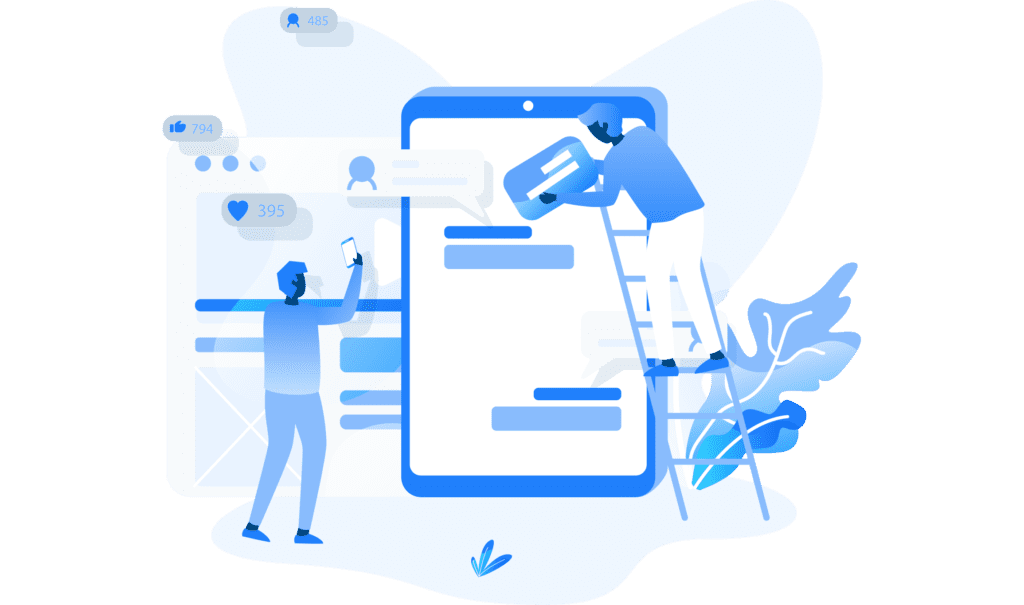
Subsequent deployments for new features or updates could create new problems that weren't there in the past. In short, something that worked with your previous release has not stopped working because of changes made during the update.
So whenever changes are made to your app, even if they're small, you need to go back and re-do the QA process. This is the only way to ensure that regression hasn't occurred and caused a new point of failure in the app.
Don't underestimate the importance of releasing new versions of your app. Users are giving you feedback, and they expect changes to be made.
Failure to improve your app can cause people to stop using it altogether.
Maintenance and Support
There will always be ongoing maintenance for your app. That's why it's crucial that you retain your development team.
In addition to your app coming out with new versions, mobile device operating systems come out with updates as well. You need to make sure that your app is compatible with the latest software versions from Apple and Android.
Compliance levels and regulations can change as well. For example, you need to ensure that your app complies with data laws like GDPR in Europe or CCPA in California. If you're processing credit card payments, you must remain PCI compliant. If you're handling medical information, the app must be HIPAA compliant. The list goes on and on.
All of these circumstances require ongoing maintenance.

Think of your app like a car. You're not done spending money on it once you drive it off of the lot. You still need to pay for gas, oil changes, tire rotations, filters, registration fees, and more.
As your app scales, you should eventually plan for customer support. What happens if an app user has a question or needs help? In the beginning, you can probably manage this on your own. But at scale, you probably can't handle hundreds or thousands of potential messages.
You might need to hire a sales team as well. All of this falls into the "support" category post-launch.
These are elements of mobile app development that you're always going to be dealing with. So just make sure you plan and budget accordingly.
How Do You Make Money With an App?
There are lots of different ways to make money with an app.
For starters, you can use a mobile app to generate more revenue for your business. Mobile commerce sales, customer loyalty programs, and referral programs are all excellent ways to make money.
You can also make money by charging app users a one-time fee to download your app. App purchases for things like coins or content upgrades are both common ways to profit from your app. Alternatively, charging app users for a subscription on a monthly or annual basis is a great way to generate recurring revenue.
Another way to monetize your app is by selling advertising space. It's the same concept of running ads on your website.
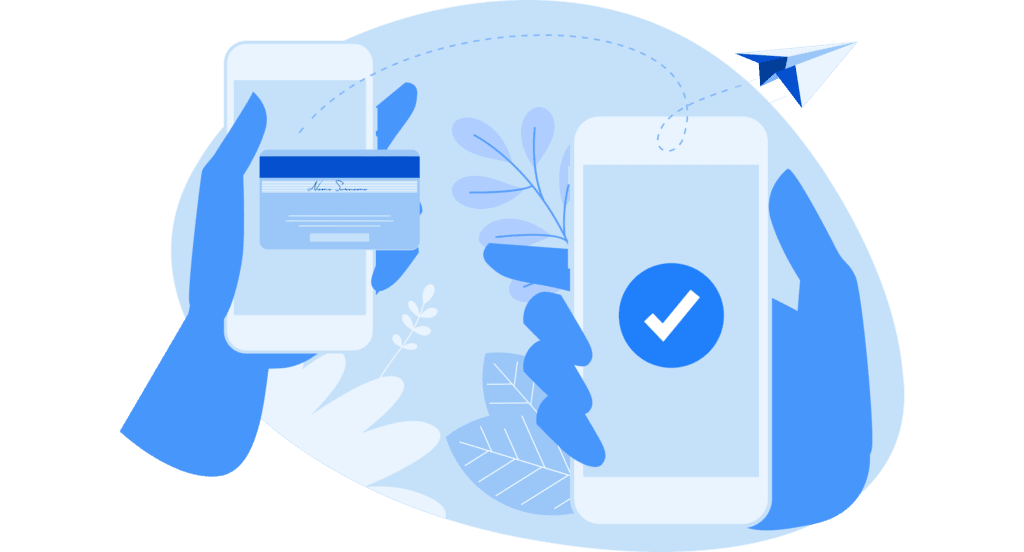
In some cases, certain types of apps don't necessarily make money, but they help save you money. Internal business apps are a perfect example of this. Creating an app for remote employees, field service workers, human resources, or internal employee communication can save your company tens of thousands of dollars per year in productivity costs.
How to Make an App — Create App FAQ
BuildFire has been used to create more than 10,000+ apps. Over the years, we've fielded countless questions from beginners and experienced app builders alike. Whether you want to make an iOS app for the Apple App Store, an Android app for the Google Play app store, or both, here are the answers to your questions:
How Much Does it Cost to Create an App?
There is no single answer to this question. It's like asking how much a car costs or how much a house costs. Just like in these analogies, the answer depends on a wide range of factors.
It all starts with your app idea. The complexity of your app will have the most significant impact on the cost.
For example, an app that uses real-time GPS tracking and real-time communication between users would be more expensive than a simple content app. An app that just provides access to a mobile ebook or flashcards would be cheaper than an app that has custom user profiles.
Here's why. Apps with all of these extra features require more work for development and more work on the back end—both of which impact the cost. Let's say you want app users to log into a unique profile every time they open the app. This requires database servers and user authentication servers. You'll also need robust security features to protect everyone's information. This stuff isn't required for a calculator app or a flashlight app.
If you want to make an app that's going to be the next Facebook, Uber, or Tinder, it's going to be much more expensive than a simple app for your small business.
Your development method will also impact your total cost.
Earlier in this guide, we talked about the five most common ways to build an app—low-level coding, hybrid apps, rapid app development, cookie-cutter apps, and BuildFire. All of these come at different price points.
Low-level coding will always be the most expensive because it requires you to hire app developers. An iOS app isn't necessarily the same price as an Android app. Hybrid apps also require technical ability, which will add to the cost.
But if you're leveraging an existing app builder, it's going to save you a ton of money.
How Do You Create an App For Free?
Mobile development typically comes with a significant investment. This is especially true if your app solves a major market need.
But if you're just getting started and want to create a free app, you can do this using BuildFire's app builder platform. This no-code software lets you build your own apps for free without writing a single line of code. This is perfect for those of you who don't want to learn a new programming language and want to play around with the custom editor.
With BuildFire, you can take an app idea and turn it into reality faster than any other platform on the market. You'll also get to create iOS apps and Android apps simultaneously using a single build.
So, what's the catch? While you can make an app for free using BuildFire, you can't actually launch it without subscribing to a plan. But anyone can try the app builder for free with a 14-day trial.
Once you're signed up and ready to put your app on the market for real downloads and user feedback, you can launch your app for free using BuildFire. All of our plans include assistance with the launch. You just need to let our team know when you're ready, and we'll get your app published live on the Apple App Store and Google app store.
As a developer, anyone can access BuildFire.js for free as well. This means you can create a custom plugin and launch it on the BuildFire marketplace. BuildFire's open-source code and SDK make this possible.
Can I Create an App by Myself?
Absolutely.
Historically, mobile development required a full team of app developers. But app developers are no longer required in the modern era. Anyone can create their own apps without coding or learning a programming language.
No-code development platforms make it easy for DIYers and non-technical users to create an app from scratch with ease. It's just a matter of choosing a template, adding plugins, and customizing the features to accommodate your needs.
These types of platforms can best be compared to website builders like Wix or Squarespace. If you've created a website for your business, you might be familiar with these tools.
This is the easiest way to take an app idea and turn it into a reality. You can make an app in weeks instead of months or years using a DIY platform like BuildFire. Not only is this the easiest and fastest way to make an app, but it's also the most cost-effective.
Hiring a team of app developers is really expensive. You'll have to pay an iOS developer, Android developer, web developer, project manager, and even quality assurance agent to check for bugs and collect user feedback. Not only will you have to pay these different people to make an app, but you'll need to continue paying them to maintain after you launch.
Instead, it's easier to make an app on your own by leveraging software that comes with a pre-existing infrastructure. So all of your authentication servers, backup servers, databases, analytics servers, and more are already at your fingertips. In fact, you don't have to worry about any of these technical aspects. You can just focus on the app design, features, and getting users. The platform will handle everything else on the back end for you.
Is It Easy to Create an App?
Again, it depends.
Let's say you want to code your own apps from scratch. In this scenario, it wouldn't be that easy. You'd need to learn new programming languages and go through extensive trial and error to write the code.
Alternatively, it's extremely easy to make an app if you're using a no-code platform like BuildFire. These tools are built specifically for non-technical users. If you're comfortable navigating the internet, you can build an app using this method.
There's still a slight learning curve, but it's gentle. The only thing you need to learn is how to use the platform itself. This is something you can figure out on your own in less than an hour or two of clicking around. Plus, most no-code app builders have tons of resources and tutorials at your disposal that will teach you how to do everything. This will really make your life easier.
Generally speaking, here's how those platforms work.
You'll start by picking an app category, like ecommerce, education, fitness, employee communication, apps for events, etc. Then within those categories, you can choose a template based on the type of app you want to build.
For example, there are templates for gym apps, barbershop apps, salon apps, schools and universities, podcasts, and more. Even within those categories, there are subcategories that you can choose—like apps for yoga instructors within the fitness and wellness category.
After you pick a template, you just need to customize it to fit your needs. You can take the generic title placeholder of "Yoga Studio" and replace it with the unique name of your Yoga business. You'll take the placeholder business address, email, and phone number and replace it with your own contact information. Continue doing this for each page of your app.
From there, you can start to add custom functionality. Do you want to add videos to your app? Or do you want to create a forum to collect user feedback?
These types of features can easily be added using plugins from the app builder marketplace. For example, you can integrate your app with YouTube or Vimeo simply by adding a video plugin to your app. Again, there's no coding or technical experience required for this.
How to Build an App: Conclusion and Key Takeaways
Building apps isn't always easy. Whether it's your first app or you've built multiple apps, there's always room for improvement. It's always a great idea to educate yourself instead of blindly picking an app development company and just hoping for the best.
Take advantage of new technology and tools at your disposal. Today, you can make an app without any coding skills. Platforms like BuildFire will even help you get published on both app stores for Apple and Google Play.
This in-depth guide on how to develop an app is just one of the many resources that we offer at BuildFire. It's broad enough to give you valuable insights on how to make an app in nearly every category. But some of you might have some more use-case specific questions about how to build an app for your business.
For example, you might want to learn how to make an app for your ecommerce site. Or maybe you want to figure out how to build an app for internal employee communication. We have guides for both of these.
We even have resources that show show you how to develop an app for schools, universities, and religious organizations. Our tutorials can teach you how to develop an app for events, podcasts, and so much more.
Need help figuring out how to build an app for your small business? We have you covered.
Contact our team of experts here at BuildFire if you have any additional questions. We're happy to help and guide you in the right direction.
How To Create Mobile Apps For Android
Source: https://buildfire.com/how-to-create-a-mobile-app/
Posted by: schmidtlonst2001.blogspot.com

0 Response to "How To Create Mobile Apps For Android"
Post a Comment